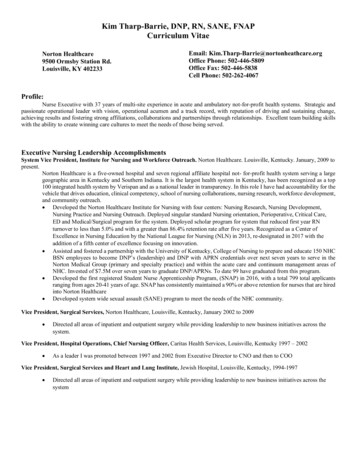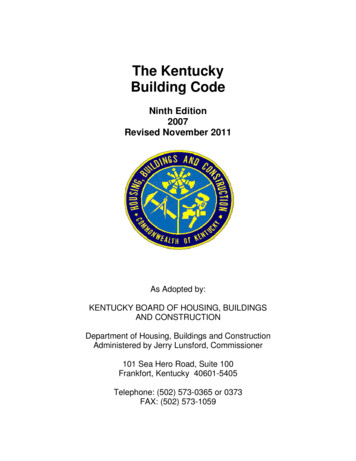
Transcription
ACTQualityPlanKNALImprovementODPQualityC HECImprovement Plan1
Executive SummaryGeorgia Heise, DrPH, District DirectorWelcome to Three Rivers’ Quality Improvement (QI) Plan! Someone once said,“What gets measured gets done.” Although the author of that statement isunknown, he or she was certainly correct. With Public Health’s limited resources,only those programs that can show outcomes receive funding. As we seek tobecome one of the first accredited health departments, Three Rivers is developinga culture of Quality Improvement by including it in everything we do. The PublicHealth Accreditation Board’s (PHAB) defines QI in public health as “use of adeliberate and defined improvement process which is focused on activities thatare responsive to community needs and improving population health. It refersto a continuous and ongoing effort to achieve measurable improvements inthe efficiency, effectiveness, performance, accountability, outcomes, and otherindicators of quality in services or processes which achieve equity and improvethe health of the community.”At Three Rivers, we must constantly monitor our programs and their outcomes.We want to ensure that we are performing all processes and services in themost effective, efficient way possible. The only way to do that is to measureour performance and make improvements when and where possible. Allour employees have received the equivalent of a college course in QualityImprovement based on The Team Handbook, by Scholtes, Joiner and Streibel.The curriculum for that course taught us how important it is assess what it is weare trying to accomplish, define the processes we are using, and to determinehow we can improve them. We learned how to employ tools such as flow charts,affinity diagrams and cause and effect diagrams. Armed with our new skills, weare embracing our Shared Vision of ALL ONE TEAM, Striving for Excellence,Educating and Empowering with every Encounter!Table of ContentsExecutive Summary.2Quality Improvement Plan Fall 2011.4Section 1: Introduction.4Section 2: Leadership and Organization .8Section 3: Goals and Objectives .9Section 4: Performance Measurement.10Section 5: Quality Improvement Initiative.12Section 6: Evaluation .13Appendix A: Quality Improvement Tools.15Appendix B: Quality Improvement Tools Specific to TRDHD .19Glossary of Terms .22Thank you,Georgia Heise DrPHDistrict Director2QualityImprovement PlanQualityImprovement Plan3
Quality Improvement PlanThree Rivers District Health DepartmentFall 2011IntroductionSection 1Introduction: Mission, Vision, Guiding Principles of TRDHDVision: All One Team, Striving for Excellence, Educating and Empowering with Every EncounterMission: The Public’s Health is Our PassionGuiding Principles:I. The communities served by TRDHD consider our delivery of the Ten Essential Public HealthServices Outstanding, while being an accredited public health department.II. Regardless of discipline, TRDHD employees work as “All One Team”, striving for excellence whileeducating and empowering with every encounter. All employees consider TRDHD a great place towork.III. The key to exemplary delivery of the Ten Essential Public Health Services is a competent publichealth workforce and the key to a competent workforce is adequate training. Furthermore, TRDHDwill be a model health department and training center for others.Our QI Story:Shortly after Three Rivers District Health Department (TRDHD) developed its Vision, “All One Team, Strivingfor Excellence, Educating and Empowering with Every Encounter,” TRDHD employees began the process ofdeveloping a strategic plan as well as a culture of quality improvement. Throughout several months, all TRDHDstaff received a series of quality improvement (QI) trainings. It was then that our past culture of “if it’s notbroke don’t fix it,” or “we’ve always done it that way,” was realized. Using The TEAM Handbook as our mainresource, staff learned the “Process Excellence” approach to quality improvement. Process Excellence is ouradopted approach to focus on giving top value to our customers by building excellence into every aspect of ourorganization.First, Process Excellence introduced us to 3 key elements: Customer Focus, Teamwork and Scientific Approach.Customer FocusScientific ApproachTeamwork Customer Focus - we learned our different types of customers, understanding their needs, and formulatingways to deliver easy, efficient and exemplary services. Scientific Approach - systems thinking was introduced, as well as ways to analyze data to better understandhow to consistently provide services and programs to meet our customer’s needs. Teamwork - TRDHD fostered teamwork which required staff to create an environment which supports trust,respect and collaboration. A common understanding of our vision, mission and shared commitments to ouragency was created.4QualityImprovement PlanSecond, QI methods highlighted in The TEAM Handbook were taught to all employees to gain a betterunderstanding of tools that can be utilized to promote quality improvement. Tools included: Pareto Charts Flow Charts Fishbone Diagrams SIPOC Diagrams Cause & Effect DiagramsAfter this was completed, employees had the skills necessary to create a list of their critical processes, and thenflow chart those critical processes. Examples of such are provided in Appendix B.To conclude our initial QI training modules, following their assessments of professional duties and improvementwithin the agency, staff had the opportunity to develop personal 5 year plans. The purpose of this was to furtherinstill the consistent message of goal-setting, evaluation, and continuous development.ipMission TranolevarTids to DisneykdnargymeTakrs Deg re eP ursue my MasteModules presented to the staff during QI training include: Fourth Generation Management Voice of the Customer Process and Systems Thinking Using Data to Learn and Improve Developing a High Functioning Team Resolving Conflict More Effectively How to Handle Difficult Conversations and Interaction More Effectively Managing the Change Process Building an Improvement PlanEach member of the Vision Team, consisting of staff in leadership positions, also participated in the BarOnEmotional Quotient Inventory which addresses emotional intelligence.QualityImprovement Plan5
During new staff orientation, the District Director is responsible for introducing Process Excellence, QIInitiatives and our Strategic Plan. Each new employee will receive a copy of TRDHD’s Strategic Plan and QualityImprovement Plan. All staff have access to each plan by means of an internal network drive. Within two weeks ofemployment at TRDHD, the new employee will receive a Quality Improvement Orientation Training, adapted fromthe National Association for County and City Health Officials (NACCHO). This presentation will be delivered by theQI Coordinator. This training can also be accessed by each employee by means of our internal network drive, titled“QI Training TRDHD.” Leadership Involvement. Strong leadership, direction and support of quality improvement activities by theDistrict Director and Board of Health are key to performance improvement. This involvement of organizationalleadership assures that quality improvement initiatives are consistent with TRDHD’s mission, vision, andstrategic plan.To continue staff training for Quality Improvement, TRDHD also has a policy devoted to Quality Improvement andPerformance Management, Policy A-IC-28, as well as each official job description at TRDHD includes the following: Statistical Tools. For continuous improvement of services and programs, tools and methods are neededthat foster knowledge and understanding. CQI organizations use a defined set of analytic tools such as flowcharts, cause and effect diagrams, flowcharts, Pareto charts, histograms, and control charts to turn data intoinformation.I. Participate in Process Excellence and TRDHD’s evaluation process.A. Actively participates in the evaluation process of co-workers when needed.Actively participates in the self-evaluation process when needed.Actively participates in the All One Team and Process Excellence meetingsand completes tasks to the TRDHD strategic plan as well as personal and professionaldevelopment. Consistently fosters a nurturing work environment.The following Quality Improvement Plan serves as the foundation of the commitment of Three Rivers DistrictHealth Department to continuously improve the quality of programs and services it provides.Quality. Quality services are services that are provided in a safe, effective, recipient-centered, timely, equitable,and efficient manner.Three Rivers District Health Department is committed to the ongoing improvement of the quality of care itscommunity members receive, as evidenced by the outcomes of programs and services. TRDHD continuouslystrives to ensure that: The programs and services provided incorporate evidence-based, effective practices;The programs and services are appropriate to each client’s needs, and available when needed;Risk to patients, providers and others is minimized, and errors in the delivery of services are prevented;Standard operating procedures are developed and utilized on a consistent basis;Programs, processes, and services are provided in a timely and efficient manner, with appropriatecoordination and continuity. Data Informed Practice. Successful QI processes create feedback loops, using data to inform practice andmeasure results. Fact-based decisions are likely to be correct decisions. Prevention Over Correction. Continuous Quality Improvement entities seek to design good processes toachieve excellent outcomes rather than fix processes after the fact. Continuous Improvement. Processes must be continually reviewed and improved. Small incremental changesdo make an impact, and employees can almost always find an opportunity to make things better.Continuous Quality Improvement Activities. Quality improvement activities emerge from a systematic andorganized framework for improvement. This framework, adopted by Three Rivers District Health Department,is understood, accepted and utilized throughout the organization, as a result of continuous education andinvolvement of staff at all levels in performance improvement. Quality Improvement involves two primaryactivities: Measuring and assessing the performance of services, programs and processes through the collection andanalysis of data. Conducting quality improvement initiatives and taking action where indicated, including the design of new services, processes, programs and/or improvement of existing services, processes and programs.The tools used to conduct these activities are described in Appendix A, at the end of this Plan. General templatesare provided as well as flow charts and diagrams specific to TRDHD.Quality Improvement Principles. Quality improvement is a systematic approach to assessing services, programsand processes and improving them on a priority basis. Three Rivers District Health Department’s approach toquality improvement is based on the following principles: Customer Focus. High quality organizations focus on their internal and external customers and on meeting orexceeding needs and expectations. Employee Empowerment. Effective programs involve people at all levels of the organization in improvingquality.6QualityImprovement PlanQualityImprovement Plan7
Section 2Leadership and OrganizationLeadership. The key to the success of the Continuous Quality Improvement process is leadership. The followingdescribes how the leaders of TRDHD provide support to quality improvement activities.The Quality Improvement Team provides ongoing operational leadership of continuous quality improvementactivities at the Three Rivers. QI Team members will spend one fiscal year serving on the team, therefore newmembership will begin every July. Each department of the agency will be represented, as well as the DistrictDirector and the Accreditation/QI Coordinator. The team will meet at least monthly or not less than ten (10) timesper year and the initial QI Team consists of the following individuals:April Harris, QI ChairpersonGeorgia Heise, District DirectorWayne Biddle, Environmental HealthMichael Boisseau, Administrative ServicesDeborah Jones, Clinic ServicesJennifer Johnson, Home HealthMelody Stafford, Health PlanningRebecca Wilson, Health EducationThis planned communication may take placethrough the following methods; Story boards and/or posters displayed incommon areas Employees participating on QI Team reportingback to departmental groups Sharing of the agency’s annual QI Planevaluation Newsletters and handouts Quarterly staff meetings facilitated by theDistrict Director and management staff.The membership of the Quality Improvement Team is based upon: District Director and departmental manager’s recommendation; Employee capability and interest.The responsibilities of the Quality Improvement Team include: Developing and approving the Quality Improvement Plan. As part of the Plan, establishing measurable objectives based upon priorities identified through the use ofestablished criteria for improving the quality and safety of clinic services. Developing indicators of quality on a priority basis. Periodically assessing information based on the indicators, taking action as evidenced through qualityimprovement initiatives to solve problems and pursue opportunities to improve quality. Establishing and supporting specific quality improvement initiatives. Reporting to the Director and District Board of Health if needed, on quality improvement activities on a regularbasis. Formally adopting a specific approach to Continuous Quality Improvement, specifically Plan-Do-Check-Act.The District Director also provides leadership for the Quality Improvement process as follows: Supporting and guiding implementation of quality improvement activities. Reviewing, evaluating and approving the Quality Improvement Plan annually. Consulting with the Quality Improvement Coordinator to develop an annual budget and resource allocation.The District Director will play a vital role in the development and maintenance of the agency Quality ImprovementPlan and its subsequent activities. Furthermore, the District Director will provide oversight on QI initiatives derivedfrom the QI Team. Quality improvement training to TRDHD will be facilitated by the District Director or appointedemployees.The Quality Improvement Team supports QI activities through the planned coordination and communication of theresults of measurement activities related to QI initiatives and overall efforts to continually improve the quality ofprograms, services and processes. This sharing of QI data and information is an important team function. Teammembers, through a shared communication approach, ensure TRDHD staff acknowledge ongoing QI initiatives asa means of continually improving performance.8QualityImprovement PlanSection 3 Goals and ObjectivesThe Quality Improvement Team identifies and defines goals and specific objectives to be accomplished each year.These goals include training of all TRDHD staff regarding both continuous quality improvement principles andspecific quality improvement initiative(s). Progress in meeting these goals and objectives is an important part ofthe annual evaluation of quality improvement activities.The following are ongoing, long term QI goals for TRDHD for the fiscal years 2011-2012, to be completed bymember for the QI Team. To implement quantitative measurement to assess key processes or outcomes; To bring managers and staff together to review quantitative data and major adverse occurrences to identifyproblems; To carefully prioritize identified problems and set goals for their resolution; To achieve measurable improvement in the highest priority areas; To provide education and training to agency staff and Board of Health members To develop or adopt necessary tools, such as standard operating procedures, consumer and employeesurveys and quality indicators.QualityImprovement Plan9
Short Team Goals:Each fiscal year, the QI Team will develop 4-6 quality improvement initiatives that are aligned with the agency’slong-term QI goals. The QI Team will facilitate the initiatives with staff in their respective departments. QITeam members will be responsible for identifying activities/projects associated with each initiative and developobjectives. The preferred method for prioritizing activities/projects is an affinity diagram. Taking action to address performance discrepancies when indicators indicate that a process is not stable, isnot performing at an expected level or represents an opportunity for quality improvement. Reporting within the organization on findings, conclusions and actions taken as a result of performanceassessment.Selection of a Performance Indicator. A performance indicator is a quantitative tool that provides informationabout the performance of an agency’s process, services, functions or outcomes. Selection of a PerformanceIndicator is based on the following considerations: Relevance to mission - whether the indicator addresses the population served Importance - whether it addresses an important process that is: high volume problem prone or high riskSection 4Performance MeasurementPerformance Measurement is the process of regularly assessing the results produced by the program. Itinvolves identifying processes, systems and outcomes that are integral to the performance of the servicedelivery system, selecting indicators of these processes, systems and outcomes, and analyzing informationrelated to these indicators on a regular basis. Continuous Quality Improvement involves taking action asneeded based on the results of the data analysis and the opportunities for performance they identify.The purpose of measurement and assessment is to: Assess the stability of processes or outcomes to determine whether there is an undesirable degree of variationor a failure to perform at an expected level. Identify problems and opportunities to improve the performance of processes. Assess the outcome of the program or service provided.Characteristics of a Performance Indicator. Factors to consider in determining which indicator to use include; Scientific Foundation: the relationship between the indicator and the process, system or outcome beingmeasured Validity: whether the indicator assesses what it purports to assess Resource Availability: the relationship of the results of the indicator to the cost involved and the staffingresources that are available Consumer Preferences: the extent to which the indicator takes into account individual or group (e.g., racial,ethnic, or cultural) preferences Meaningfulness: whether the results of the indicator can be easily understood, the indicator measures avariable over which the program has some control, and the variable is likely to be changed by reasonablequality improvement efforts. Assess whether a new or improved process meets performance expectations.Measurement and assessment involves: Selection of a process or outcome to be measured, on a priority basis. Identification and/or development of performance indicators for the selected process or outcome to bemeasured. Aggregating data so that it is summarized and quantified to measure a process or outcome. Assessment of performance with regard to these indicators at planned and regular intervals.10QualityImprovement PlanQualityImprovement Plan11
The Performance Indicator Selected for the Three Rivers Quality Improvement Plan: For purposes of this plan,an indicator(s) comprises five key elements: name, definition, data to be collected, the frequency of analysis orassessment, and preliminary ideas for improvement.Assessment. Assessment is accomplished by comparing actual performance on an indicator with: Self over time. Pre-established standards, goals or expected levels of performance. Information concerning evidence based practices. Other local health departments or similar providers. Quarterly status reports included in our Strategic Plan.Section 5Quality Improvement InitiativeOnce the performance of a selected process has been measured, assessed and analyzed, the information gatheredby the above performance indicator(s) is used to identify a continuous quality improvement initiative to beundertaken. The decision to undertake the initiative is based upon agency priorities. The purpose of an initiative isto improve the performance of existing services or to design new ones. The model utilized at Three Rivers DistrictHealth Department is called Plan-Do-Check-Act (PDCA). PDCA is widely recognized as a comprehensive qualityimprovement method. The TEAM Handbook also outlines the PDCA Cycle on page 5-27 & 5-39.Improvement projects are supported by several components in TRDHD’s Strategic Plan.Specifically: Goal 10: Research for New Insights and Innovative Solutions to Health Problems, Objective 2: Increase QualityImprovement, Action Step A, Establish Quality Improvement Team. Goal 10, Research for New Insights and Innovative Solutions to Health Problems, Objective 8: Deliver ProcessExcellence Curriculum, Action Step A: Enroll Staff and Participate in Process Excellence Curriculum Goal 12: TRDHD is a Model Health Department and Training Center for Others, Objective 2, Become a TrainingCenter, Action Step B: Design a Path for Accreditation Goal 12: TRDHD is a Model Health Department and Training Center for Others, Objective 3, Strive to Bea Learning Organization Through Continuous Improvement, Action Step A: Deliver Process ExcellenceCurriculumSection 6EvaluationAn evaluation is completed at the end of each fiscal year. The annual evaluation is conducted by the QualityImprovement Team and kept on file with the District Director. Evaluation will be completed by those members ofthe Quality Improvement Team, as well as open to all staff members and board of health members. The QualityImprovement Plan, as well as evaluation findings, will be kept on file with the District Director, as well as TRDHD’sinternal network drive.The evaluation for the QI Team is responsible for summarizing the goals and objectives of the QualityImprovement Plan, the quality improvement activities conducted during the past fiscal year, including the targetedprocess, systems and outcomes, the performance indicators utilized, the findings of the measurement, dataaggregation, assessment and analysis processes, and the quality improvement initiatives taken in response to thefindings. Plan - The first step involves identifying preliminary opportunities for improvement. At this point the focus isto analyze data to identify concerns and to determine anticipated outcomes. Ideas for improving processesare identified. This step requires the most time and effort. Affected staff or people served are identified, datacompiled, and solutions proposed. (For tools used during the planning stage, see sections “a” thru “k” inAPPENDIX: A. ) Do - This step involves using the proposed solution, and if it proves successful, as determined throughmeasuring and assessing, implementing the solution usually on a trial basis as a new part of the process. Check - At this stage, data is again collected to compare the results of the new process with those of theprevious one. Act - This stage involves making the changes a routine part of the targeted activity. It also means “Acting” toinvolve others (other staff, program components or consumers) - those who will be affected by the changes,those whose cooperation is needed to implement the changes on a larger scale, and those who may benefitfrom what has been learned. Finally, it means documenting and reporting findings and follow up.(APPENDIX: B includes tools used during PDCA specific to QI initiatives at TRDHD.)12QualityImprovement Plan Summarize the progress towards meeting the Annual Goals/Objectives. For each of the goals, include a brief summary of progress including progress in relation to training goal(s). Provide a brief summary of the findings for each of the indicators you used during the year. These summariesshould include both the outcomes of the measurement process and the conclusions and actions taken inresponse to these outcomes. Summarize your progress in relation to your Quality Improvement Initiative(s).For each initiative, provide a brief description of what activities took place including the results on yourindicator. What are the next steps? Describe any implications of the quality improvement process for actionsto be taken regarding outcomes, systems or outcomes at your program in the coming year.QualityImprovement Plan13
Recommendations: Based upon the evaluation, state the actions you see as necessary to improve theeffectiveness of the QI Plan and overall QI Team. Also include “Lessons Learned.”The evaluation for the agency’s employees and board of health members will be completed by means of ananonymous survey. This evaluation will focus on: Summarize the progress towards meeting the Annual Goals/Objectives. Provide feedback for the Quality Improvement processes and projects. Recommendations: state the actions you see necessary to improve the effectiveness of the QI Plan and overallQI Team. Summarize your progress in relation to your Quality Improvement Initiatives performed by your respectiveteam, or of the QI Initiatives in other areas.APPENDIX A. Quality Improvement ToolsFollowing are some of the tools available to assist in the Quality Improvement process.a. Flow Charting: Use of a diagram in which graphic symbols depict the nature and flow of the steps in aprocess. This tool is particularly useful in the early stages of a project to help the team understand how theprocess currently works. The “as-is” flow chart may be compared to how the process is intended to work.At the end of the project, the team may want to then re-plot the modified process to show how the redefinedprocess should occur. The benefits of a flow chart are that it:1. Is a pictorial representation that promotes understanding of the process2. Is a potential training tool for employees3. Clearly shows where problem areas and processes for improvement are.Flow Chart SymbolsFlow charting allows the team toidentify the actual flow-of-eventsequence in a process.b. Brainstorming: A tool used by teams to bring out the ideas of each individual and present them in anorderly fashion to the rest of the team. Essential to brainstorming is to provide an environment free ofcriticism. Team members generate issues and agree to “defer judgement” on the relative value of each idea.Brainstorming is used when one wants to generate a large number of ideas about issues to tackle, possiblecauses, approaches to use, or actions to take. The advantages of brainstorming are that it:1.2.3.4.5.Encourages creativityRapidly produces a large number of ideasEqualizes involvement by all team membersFosters a sense of ownership in the final decision as all members actively participateProvides input to other tools: “brain stormed” ideas can be put into an affinity diagram or they can bereduced by multi-voting.c. Decision-making Tools: While not all decisions are made by teams, two tools can be helpful when teamsneed to make decisions.1. Multi-voting is a group decision-making technique used to reduce a long list of items to a manageablenumber by means of a structured series of votes. The result is a short list identifying what is importantto the team. Multi-voting is used to reduce a long list of ideas and assign priorities quickly with a highdegree of team agreement.2. Nominal Group technique-used to identify and rank issues.14QualityImprovement PlanQualityImprovement Plan15
d. Affinity Diagram: The Affinity Diagram is often used to group ideas generated by brainstorming. It is a toolthat gathers large amounts of language data (ideas, issues, opinions) and organizes them into groupingsbased on their natural relationship. The affinity process is a good way to get people who work on a creativelevel to address difficult, confusing, unknown or disorganized issues. The affinity process is formalized in agraphic representation called an affinity diagram. This process is useful to:f. Histogram: This is a vertical bar chart which depicts the distribution of a data set at a single point in time.A histogram facilitates the display of a large set of measurements presented in a table, showing where themajority of values fall in a measurement scale and the amount of variation. The histogram is used in thefollowing situations:1. To graphically represent a large data set by adding specification limits one
deliberate and defined improvement process which is focused on activities that are responsive to community needs and improving population health. It refers to a continuous and ongoing effort to achieve measurable improvements in the efficiency, effectiveness, performance, accountability, outcomes, and other











